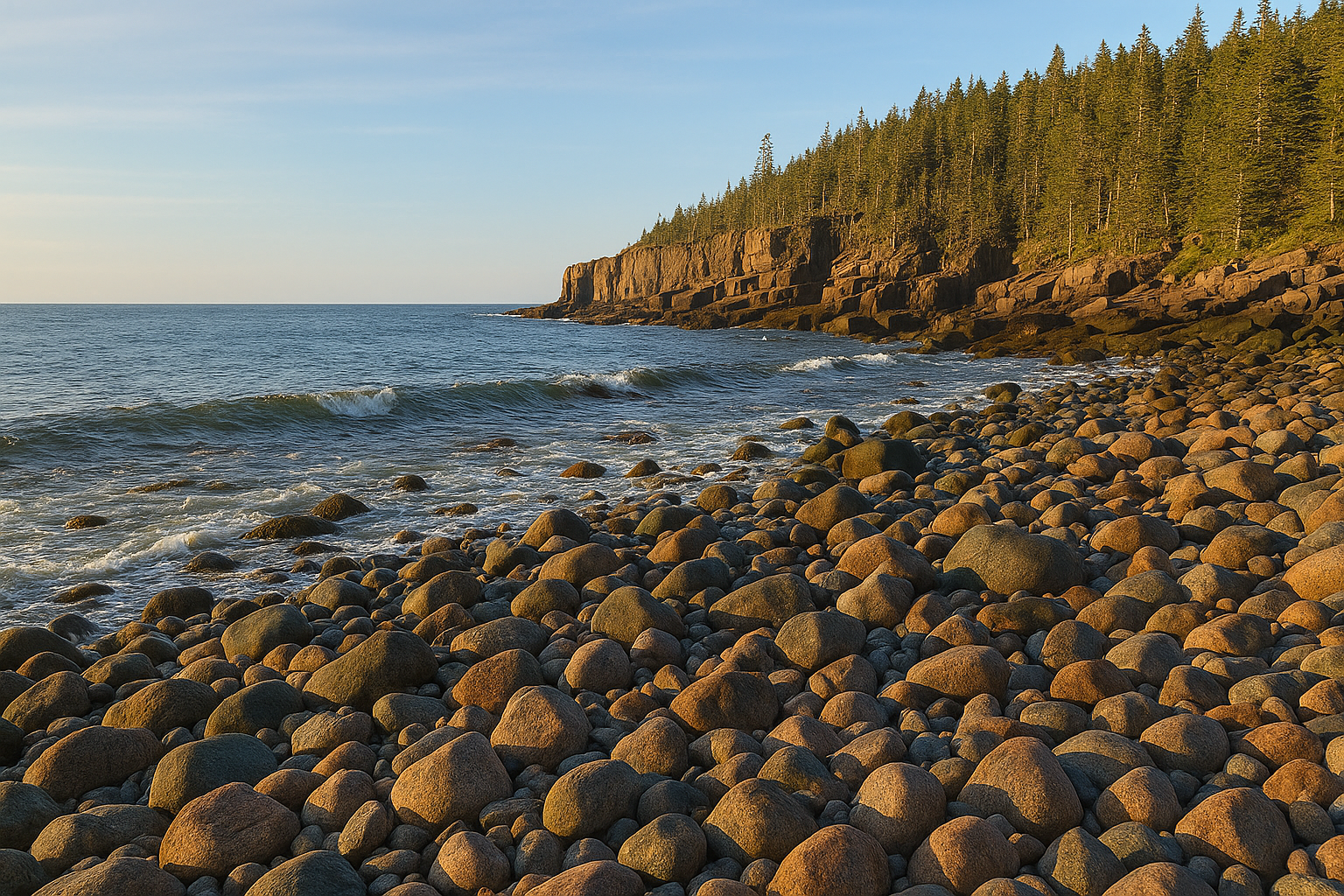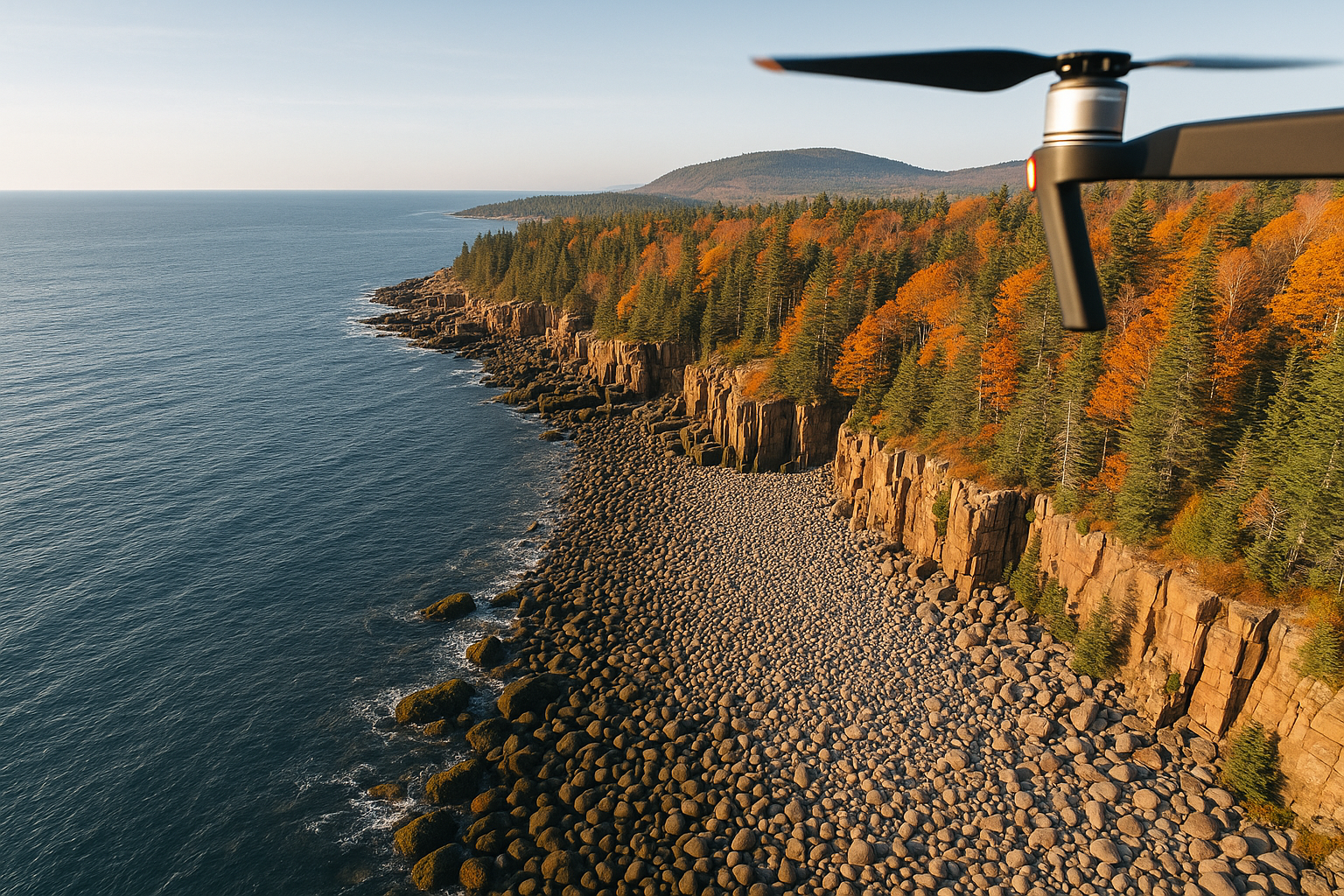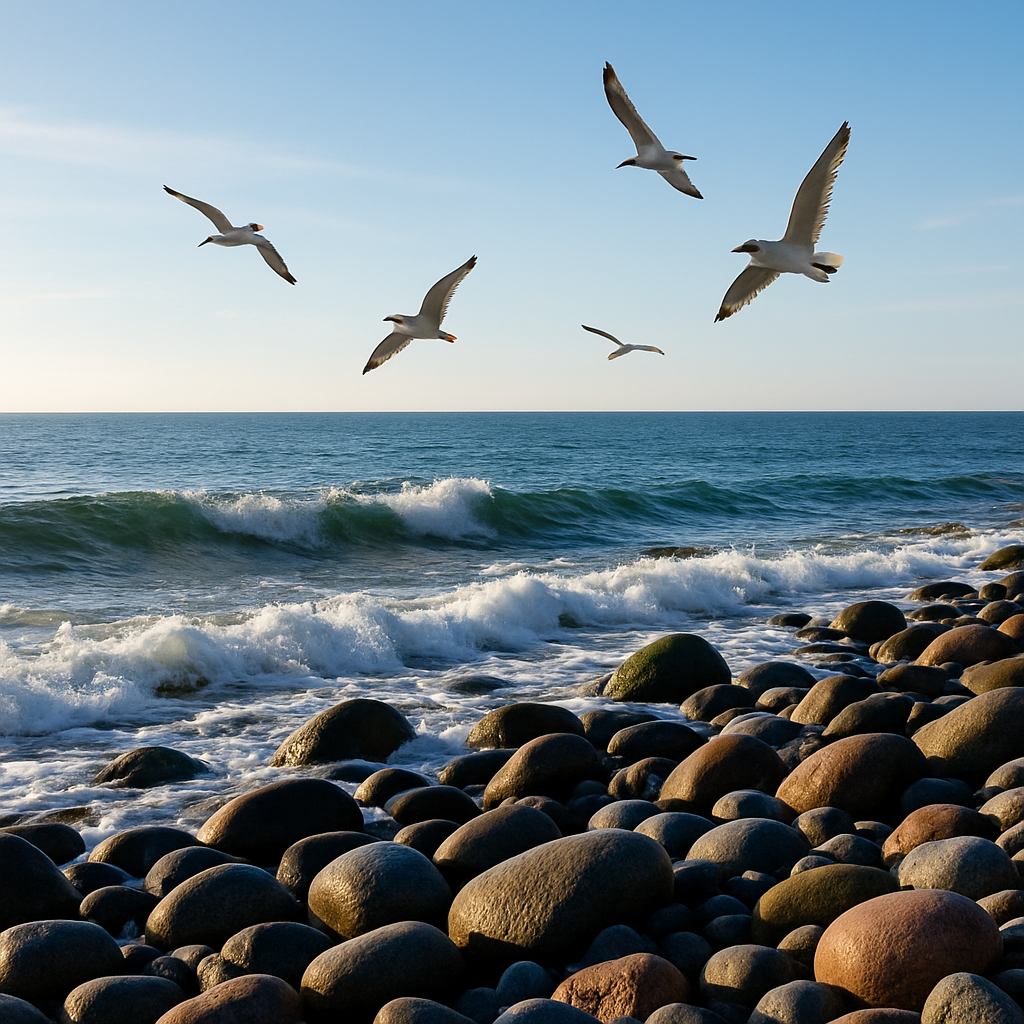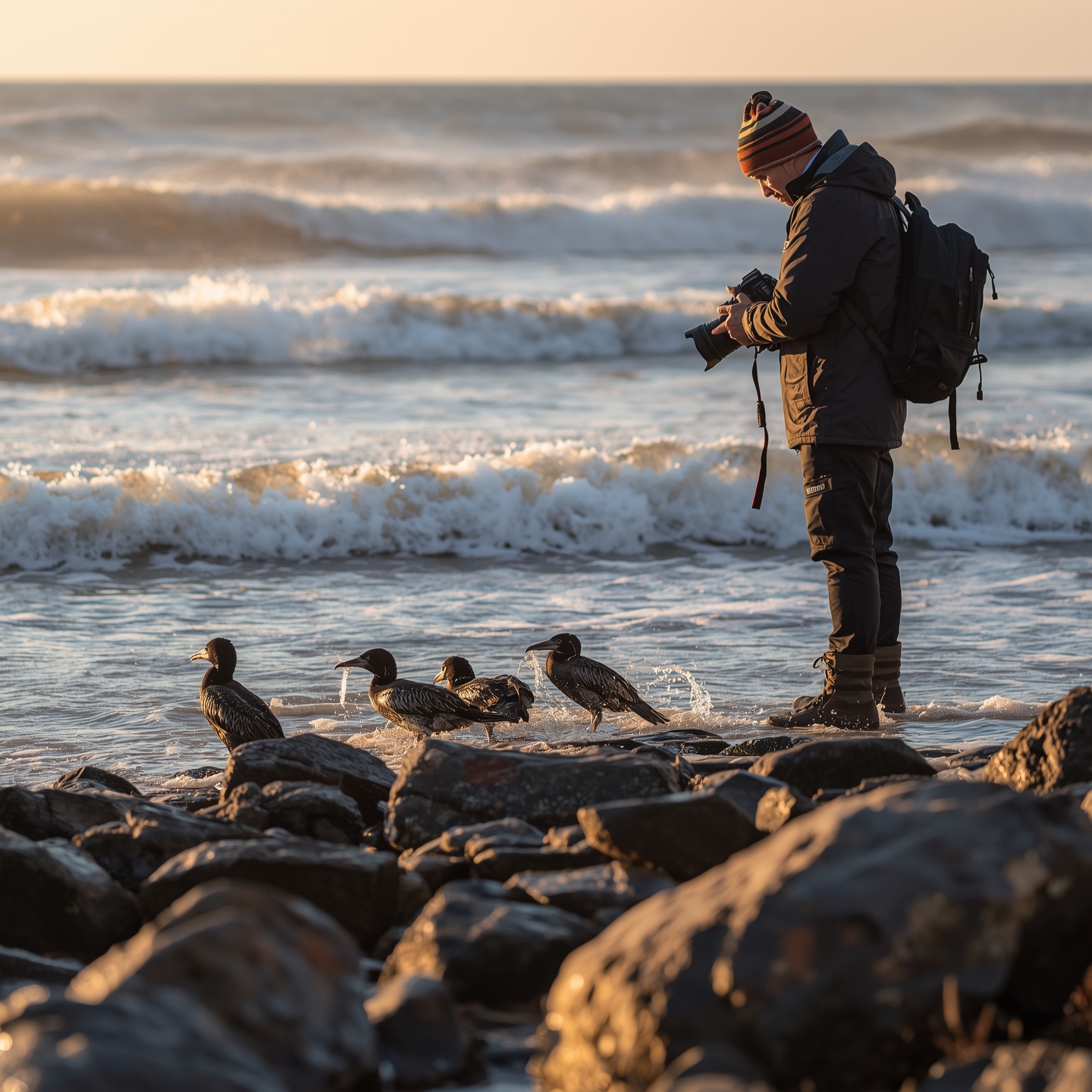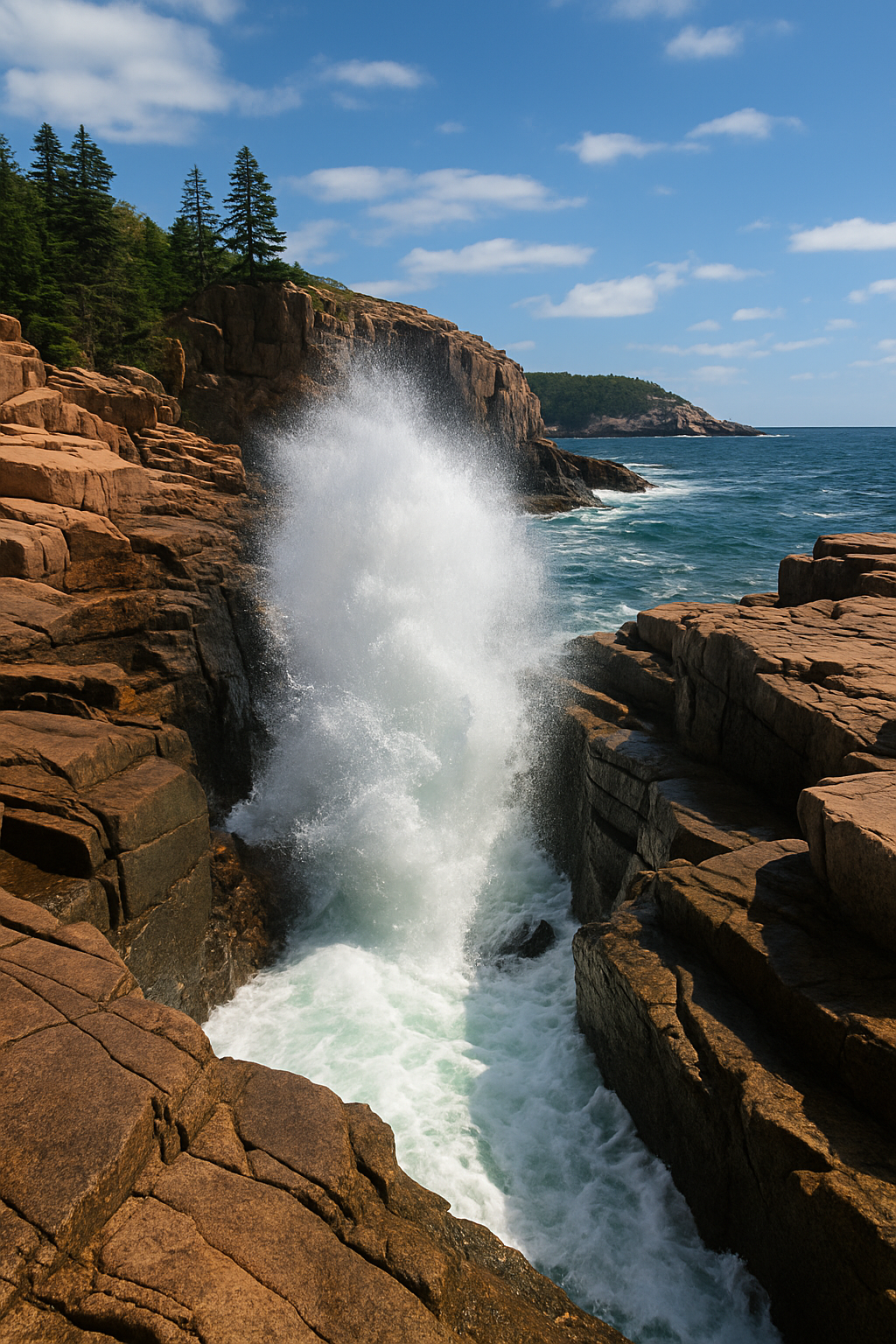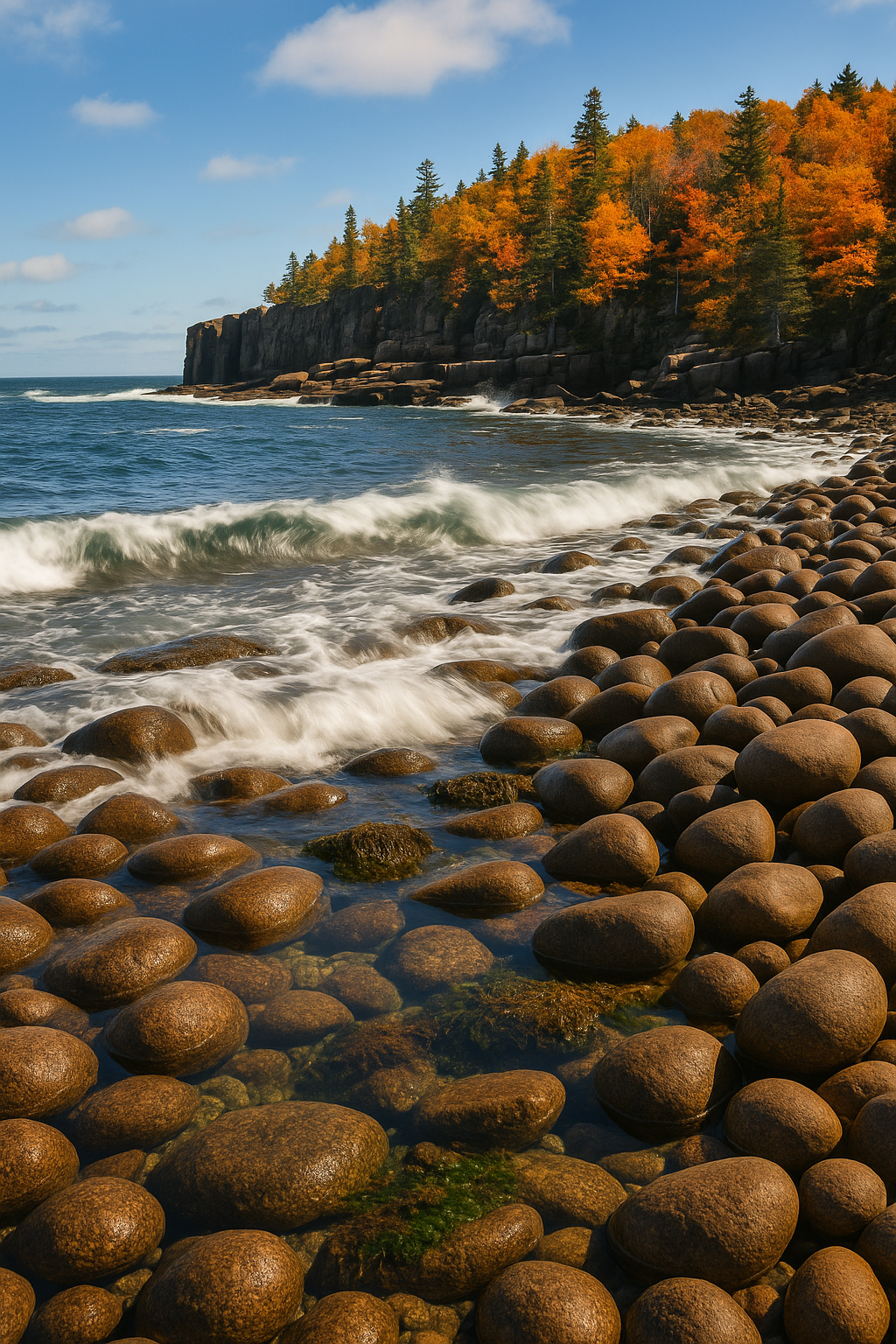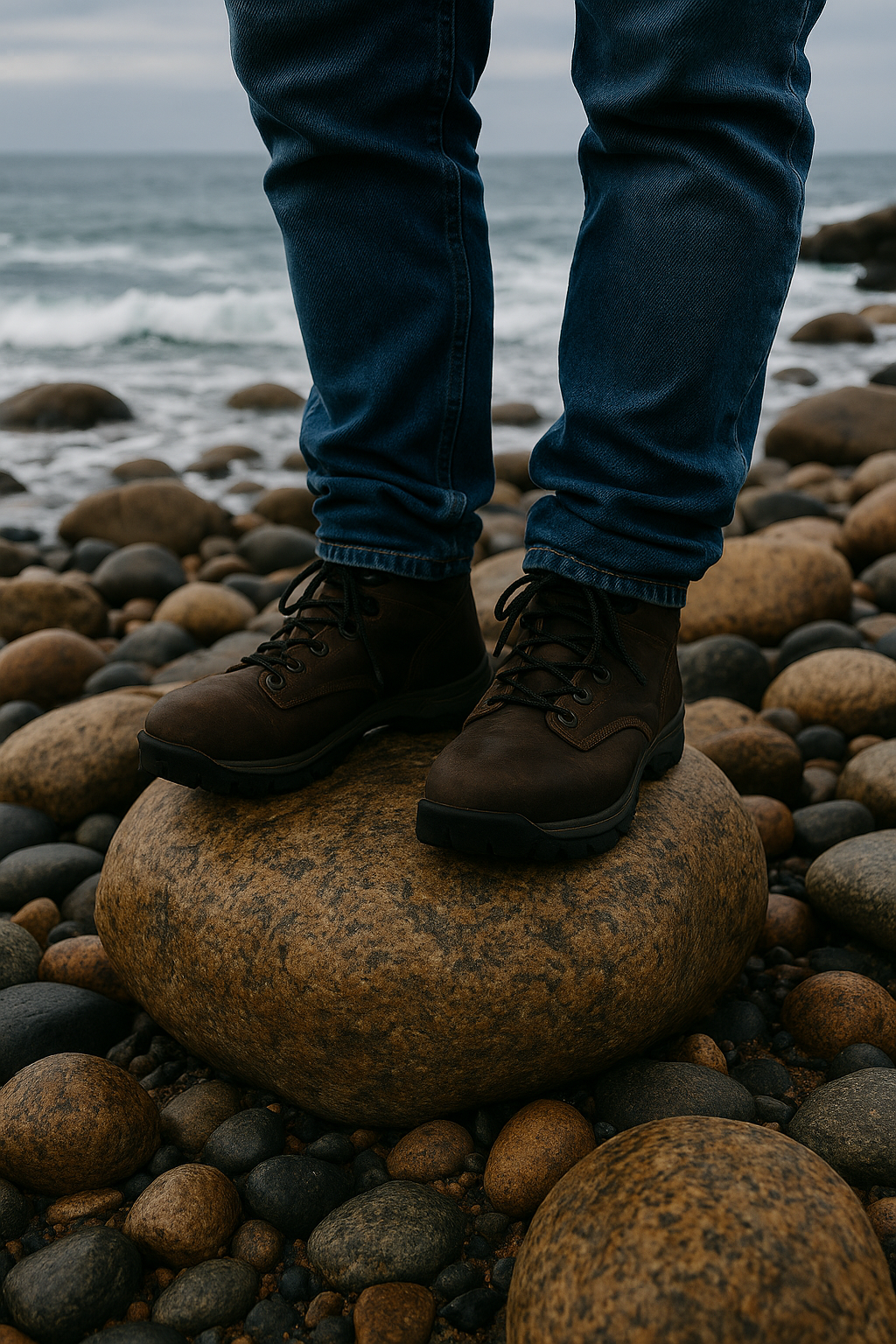Boulder Beach Acadia National Park
Boulder Beach Acadia is one of the National Park’s most unique and visually striking shorelines, famous for its perfectly rounded cobblestones and dramatic views of the Atlantic. Tucked along the Park Loop Road between Otter Cliff and Monument Cove, it’s a place that feels both wild and peaceful — a blend of rugged coastal scenery and natural artistry that only time and the ocean could create.
Whether you’re here to capture the first light of day over Otter Cliffs, explore tidepools teeming with marine life, or simply soak in the sound of waves rolling over smooth stones, Boulder Beach delivers an experience unlike any of Acadia’s sandy shores.
Boulder Beach Acadia - Why Is It So Unique
Boulder Beach Acadia is one of the most distinctive stretches of shoreline in the entire park, and it offers a completely different experience than the sandy or freshwater spots nearby. Unlike Sand Beach’s soft golden sand or Echo Lake’s calm freshwater swimming, Boulder Beach is made up almost entirely of smooth, rounded stones that range in size from golf balls to basketballs. These natural cobblestones are the product of thousands of years of geological forces at work — from glacial activity that deposited the granite, to freeze-thaw cycles that cracked the rock, to the endless action of waves that polished each stone smooth.
Walking across the beach feels a bit like stepping into an open-air gallery of natural sculpture. Each cobble has been shaped and polished by time, with subtle differences in color, texture, and size that create an endless variety underfoot. Some stones shimmer with mica in the sunlight, while others take on earthy tones of red, brown, and gray. Collectively, they form a mosaic-like shoreline that feels as much a work of art as a geological feature.
What makes Boulder Beach even more memorable is its sound. As the tide moves in and out, the waves roll the cobbles back and forth, causing them to clatter and click together. The rhythmic sound is unlike anything you’ll hear at a sandy beach — a distinctive soundtrack that stays with you long after you’ve left. On calm days it’s a gentle murmur, but when the surf is up, the stones create a loud, almost musical chorus that blends with the crash of the waves.
The beach also gives visitors a strong sense of Acadia’s natural history. Standing here, you can picture the glaciers that once carved out Mount Desert Island, the powerful storms that continually reshape the coast, and the daily ebb and flow of tides that never stop moving the stones. Every rock tells part of that story.
For photographers, Boulder Beach is a dream. The foreground of polished stones, midground of rolling surf, and background of towering Otter Cliff create layers of depth that make for striking compositions in any season. At sunrise, the stones glow with golden light; in autumn, the cliff blazes with color; in winter, frost and snow dust the cobbles with a quiet beauty.
Whether you come to listen to the sound of the stones, capture dramatic images, or simply sit and take in the view, Boulder Beach offers an experience that’s both raw and meditative. It’s a reminder that not all shorelines are meant for swimming or sunbathing — some, like this one, are places where the power of nature and the passage of time are written into every stone.
Boulder Beach Acadia - Best Time To Visit
If you’ve seen photographs of Boulder Beach Acadia, chances are they were taken at sunrise. This is the most famous and magical time to visit. As the first rays of light break the horizon, they strike the face of Otter Cliffs, painting the granite in brilliant shades of orange and pink while the water takes on a golden shimmer. The combination of glowing cliffs, polished cobbles, and crashing surf creates one of the most iconic views in Acadia National Park. It’s no wonder that photographers from all over the world gather here in the early hours, tripods set firmly among the stones, hoping to capture the perfect frame. For visitors who simply want to take in the atmosphere, sunrise also offers a sense of peace and solitude that is hard to find later in the day.
But Boulder Beach has much to offer beyond the dawn light:
- Sunrise: Best for photography and peaceful solitude. The golden hour highlights the smooth stones and creates dramatic contrasts between the cobbles, surf, and cliffs. Arrive at least 30–45 minutes early to secure a good vantage point, and don’t forget sturdy shoes — the rocks can be slick with morning dew.
- Midday: When the sun climbs higher, the focus shifts to the intertidal zone. This is the best time for tidepool exploration, when you can spot periwinkle snails, crabs, mussels, and sea stars tucked among the rocks. With bright daylight, the natural colors of the cobbles also stand out — grays, reds, and browns sparkle underfoot.
- Late Afternoon: Crowds thin as the day winds down, and the low-angle light adds warmth to the scene. The softer glow makes the stones look richer in tone, and seabirds such as gulls, cormorants, and even the occasional osprey can often be seen hunting just offshore. It’s a quieter, more relaxed time for both photography and reflection.
- Evening & Dusk: While Boulder Beach isn’t a sunset hotspot in the same way as Bass Harbor Head Lighthouse, the fading light still creates moody, atmospheric conditions. If you enjoy solitude, this can be one of the most peaceful times to sit and listen to the waves rolling over the cobbles.
Whether you come at sunrise for the iconic view, midday for tidepools, or afternoon for a calmer experience, each time of day offers something unique. Boulder Beach Acadia rewards those who linger, allowing you to see how the light and tide transform the shoreline hour by hour.
Photography at Boulder Beach Acadia
Boulder Beach Acadia is a must-visit for photographers. The scene here almost feels like it was designed for the camera: a foreground of smooth, rounded cobbles, a midground of Atlantic waves crashing ashore, and the dramatic backdrop of Otter Cliffs towering above the water. This natural layering gives photographs perfect depth and balance, whether you’re shooting wide landscapes or more intimate close-ups of tidepools and textures.
Lighting plays a huge role at Boulder Beach. On clear mornings, the rising sun bathes the cobbles in warm golden light, while the cliffs ignite with glowing color. On foggy days, the mood shifts entirely — the scene takes on a misty, mysterious quality that emphasizes shape and atmosphere over color. Both conditions can yield stunning results, and many photographers return at different times of day and in varying weather to capture Boulder Beach in multiple moods.
Photography tips for Boulder Beach:
- Use a wide-angle lens (16–35mm range) to include both the stones in the foreground and the towering cliffs in the background for a sense of scale.
- Experiment with a neutral density (ND) filter if you want silky, flowing water effects on the incoming waves. Long exposures also help emphasize the smoothness of the rounded stones.
- Arrive at low tide if you want to highlight tidepool details — reflections, seaweed, and small marine life add character and interest to close-ups.
- Visit at high tide to capture dramatic wave action, especially on windy days when surf collides with the cobbles.
- Get low to the ground. Positioning your camera close to the stones exaggerates their texture and makes for striking compositions.
- Tripod recommended. For long exposures at dawn or in low light, a tripod will ensure sharp results.
Boulder Beach’s ever-changing light and sea conditions mean no two visits will yield the same photograph. It’s one of Acadia’s most rewarding spots for creative experimentation — whether you’re chasing postcard-worthy sunrise shots or moody black-and-white seascapes.
Wildlife and Tidepools at Boulder Beach Acadia
Though Boulder Beach Acadia is not a swimming beach, its intertidal zone is alive with color and activity. When the tide goes out, the rounded cobbles reveal shallow pools that act like miniature aquariums, giving you a close-up look at some of Acadia’s most fascinating wildlife.
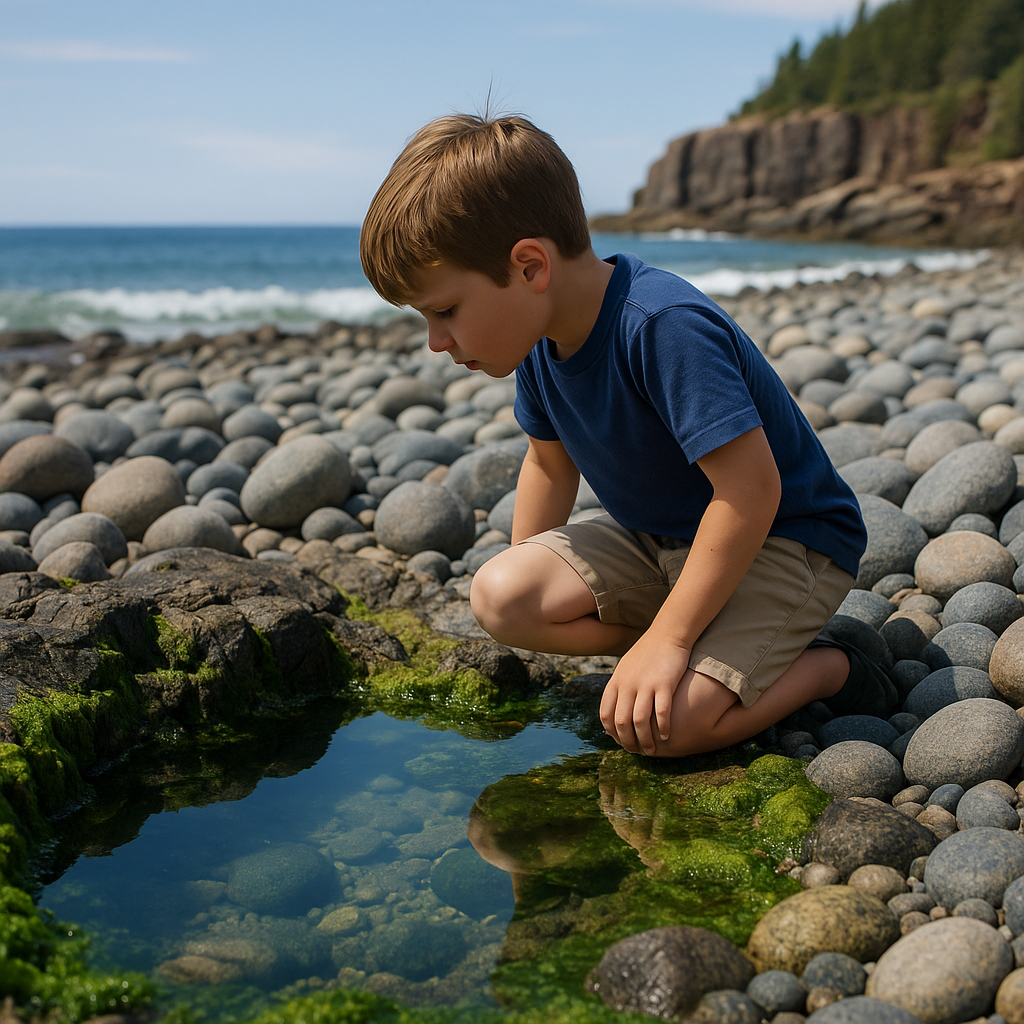
As you explore, keep an eye out for:
- Sea stars clinging firmly to the rocks, often in brilliant shades of orange or purple.
- Periwinkle snails and blue mussels, huddled together in clusters on the damp stones.
- Crabs scuttling quickly under seaweed or hiding in crevices between cobbles.
- Barnacles and limpets, adding texture to nearly every exposed rock.
- Occasional harbor seals just offshore, resting on nearby ledges or popping their heads above the waves.
- Rockweed and kelp, providing food and shelter for smaller creatures while adding to the rugged beauty of the shoreline.
These tidal pools aren’t just beautiful — they’re delicate ecosystems. Please remember:
- Tidepool creatures are fragile. Step carefully on dry rocks instead of inside pools.
- Never remove marine life from the water — everything here plays a role in the balance of the shoreline.
- Use your eyes, not your hands. Photography and observation are the best ways to take the tidepool experience home.
How to Get to Boulder Beach Acadia
Finding Boulder Beach Acadia National is easier once you know the landmarks to watch for. Tucked between Thunder Hole and Otter Cliff, the beach is just off Park Loop Road, Acadia’s famous 27-mile scenic drive. Because it isn’t marked as prominently as other attractions, many visitors drive right past it without realizing they’ve missed one of the park’s most unique coastal treasures.
If you’re driving south from Bar Harbor, you’ll pass Sieur de Monts, Sand Beach, and the thundering blowhole at Thunder Hole. Continue along Park Loop Road as it begins to curve, and you’ll soon approach the dramatic granite walls of Otter Cliff. Just before the cliff, look for a small roadside pull-off on your right — this is the parking area for Boulder Beach. From here, a short rocky pathway leads down to the cobbled shoreline. The descent can be uneven, so sturdy shoes are recommended.
To the south of Boulder Beach lies another striking landmark: Monument Cove. This small inlet is famous for its tall granite sea stack that rises straight from the ocean. It makes an excellent orientation point — if you’ve reached Monument Cove, you’ve driven just past the turn-off for Boulder Beach. Many visitors stop at both places in one visit, photographing sunrise light over the cobbles at Boulder Beach and then heading to Monument Cove for sweeping cliffside views.
When you step onto Boulder Beach itself, you’ll find thousands of rounded granite cobbles ranging from fist-sized stones to basketball-sized boulders, polished smooth by decades of Atlantic waves. It’s not a swimming beach, but it’s a spectacular spot for photography, tidepool exploration, and simply listening to the crash of the surf against the rocks.
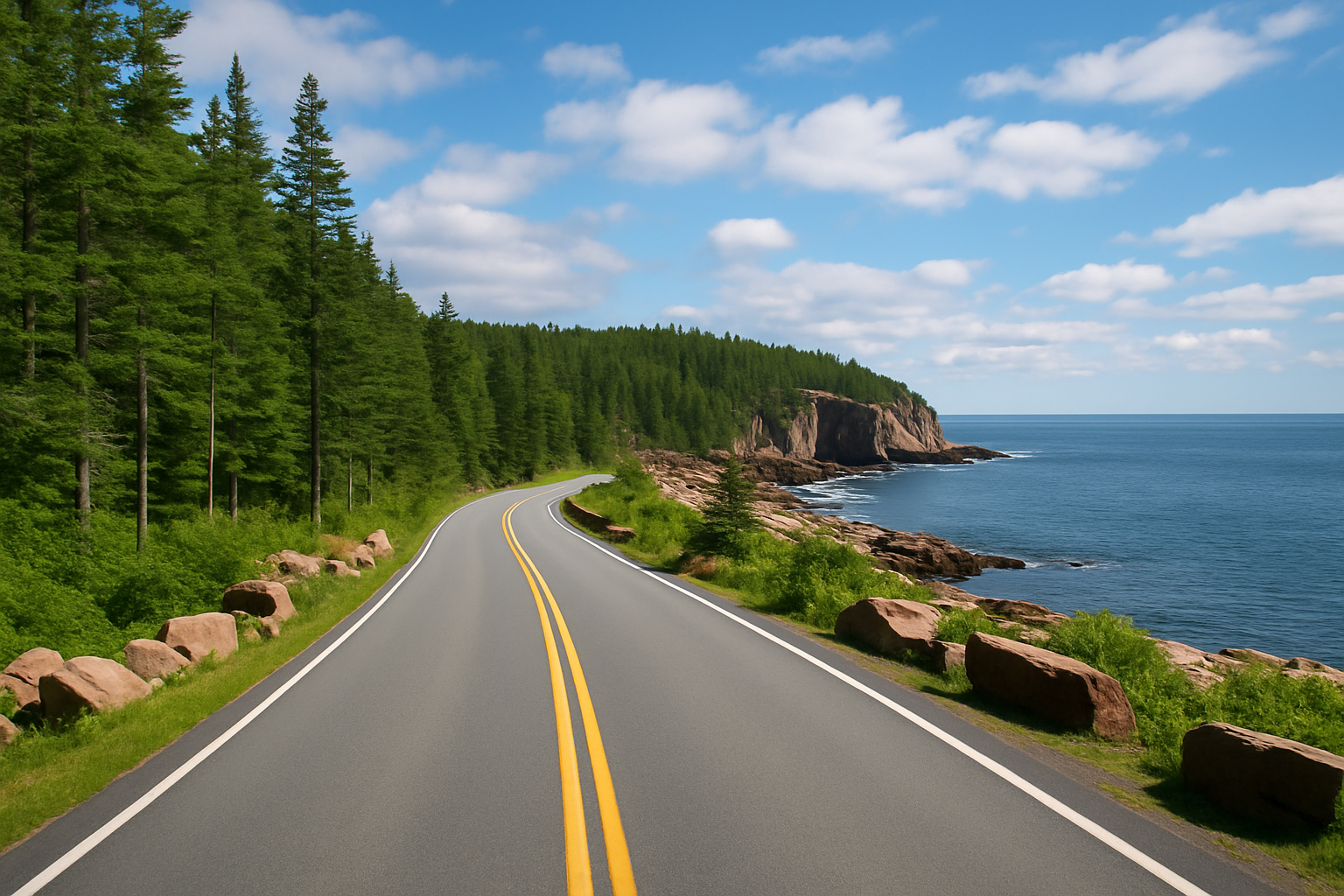
Tips for visiting:
- Arrive early or later in the day — the roadside parking area is small and fills quickly in summer.
- Use a park map or GPS — Boulder Beach isn’t as well marked as Thunder Hole or Otter Cliff.
- Wear sturdy shoes — the cobbles are uneven and can be slippery when wet.
- Combine your visit with nearby highlights: Thunder Hole, Otter Cliff, and Monument Cove are all within minutes of each other.
- Photographers should consider sunrise — the first light striking the cobbles with Otter Cliff glowing in the distance is one of Acadia’s classic scenes.
Driving to Boulder Beach Acadia is part of the experience. Park Loop Road itself is one of the most scenic drives in America, hugging the rugged shoreline with constant ocean views. Whether you’re stopping briefly to take in the view or spending time exploring the intertidal pools, Boulder Beach rewards those who take the time to find it.
Nearby Attractions
One of the best things about stopping at Boulder Beach Acadia is that it places you right in the heart of Acadia’s most dramatic stretch of coastline. Within just a few minutes along Park Loop Road, you’ll find several of the park’s most iconic stops. Pairing your visit to Boulder Beach with these nearby attractions makes for an easy half-day itinerary.
- Thunder Hole – Only a short drive north, this natural rock inlet is famous for its booming crashes of water when the tide is right. Plan your visit around mid-tide for the best chance to hear and feel the thunderous roar that gives this spot its name. Elevated walkways provide safe viewing, and kids especially love the power of the waves.
- Otter Cliff – Just beyond Boulder Beach, Otter Cliff towers more than 100 feet above the Atlantic and offers some of the most breathtaking ocean views in Acadia. Popular with both hikers and rock climbers, the cliff is also a favorite spot for photographers capturing sunrise or stormy seas. Even if you don’t leave your car, the roadside pull-off delivers jaw-dropping vistas.
- Monument Cove – South of Boulder Beach lies this picturesque inlet, marked by a granite sea stack standing boldly against the surf. Many visitors walk down to the cove’s edge for photos, but even a roadside stop gives you a postcard-worthy view. Because it’s less crowded than Sand Beach or Thunder Hole, Monument Cove often feels like a hidden gem.
- Sand Beach – About 10 minutes back toward Bar Harbor, this is the park’s most popular swimming beach and a great contrast to Boulder Beach’s cobbles. Surrounded by mountains and rocky headlands, Sand Beach is the only sandy ocean beach in Acadia and a great place for a picnic or a summer dip in the chilly Atlantic.
- Gorham Mountain Trail – Trailheads for Gorham Mountain are nearby, making it easy to add a hike to your visit. The trail climbs to a summit with sweeping views over Boulder Beach, Otter Cliff, and the islands scattered offshore. It’s a moderate hike and a perfect way to combine coastal scenery with a bit of elevation.
- Ocean Path – For those who prefer walking to driving, Ocean Path runs along this entire stretch of coast. From Sand Beach past Thunder Hole, Boulder Beach, and down toward Otter Cliff, the path offers constant sea views and access points to the shoreline. It’s one of the most rewarding and family-friendly walks in the park.
Together, these attractions make Boulder Beach a natural stop on any Acadia itinerary. Whether you’re interested in dramatic wave action, towering cliffs, hidden coves, or peaceful trails, the area surrounding Boulder Beach packs some of the park’s most memorable experiences into just a few miles.
Seasonal Highlights at Boulder Beach Acadia
Boulder Beach Acadia offers something different in every season, making it one of the most rewarding places in Acadia National Park to return to throughout the year. Its mix of smooth cobbles, crashing waves, and the towering backdrop of Otter Cliff creates a scene that constantly shifts with the seasons and weather.
In summer, mornings are warm and inviting, making sunrise photography especially comfortable. Early risers are rewarded with golden light spilling across the stones while the Atlantic sparkles in the background. The tidepools are at their busiest, filled with crabs, periwinkles, and mussels, making summer a favorite for families and nature enthusiasts alike.
When autumn arrives, the landscape transforms into a painter’s palette of fiery reds, oranges, and golds. The forested slopes above Otter Cliff ignite with color, contrasting beautifully against the gray stones and deep blue sea. Photographers flock here to capture the drama of fall foliage paired with the motion of waves rolling across the cobbles.
In winter, Boulder Beach Acadia becomes a peaceful, almost otherworldly place. Waves crash against frost-covered cobbles, sending up spray that glitters in the low sun. Snow often dusts the shoreline, adding a rare quietness that contrasts with the busy summer months. For those willing to brave the cold, the solitude and icy beauty make this one of Acadia’s most atmospheric spots.
By spring, life begins to return to the shoreline. Fresh greenery emerges and wildflowers bloom along the trails leading to the beach, offering splashes of color against the rugged granite. Migrating seabirds can often be spotted just offshore, and the longer days provide more opportunities to linger by the water.
Every season brings its own personality, meaning that no two visits to Boulder Beach ever feel the same. Whether you prefer the warmth of summer, the brilliance of autumn, the solitude of winter, or the renewal of spring, this shoreline always has something new to offer.
Safety Tips for Visiting Boulder Beach
Because of its unique cobblestone shoreline and exposed location, Boulder Beach requires a little extra care when exploring. Following a few simple guidelines will help you stay safe and make the most of your visit.
- Wear sturdy, non-slip footwear. The rounded stones constantly shift underfoot, and when wet they can be as slick as ice. Hiking shoes or sandals with grip are far better than flip-flops.
- Be mindful of the tides. At high tide, much of the cobble shore disappears beneath the surf, while at low tide you’ll have more space to explore tidepools and marine life. Check the tide chart before your visit and plan accordingly.
- Watch your balance. Photographers often crouch low for dramatic perspectives of the cobbles and cliffs, but rogue waves can surge farther than expected. Keep your gear and footing secure if you set up close to the waterline.
- Avoid climbing on wet rocks near the water’s edge. They are the most slippery and dangerous, especially when waves are strong. It’s best to observe the surf from a safe distance.
- Respect the wildlife. Tidepool creatures are fragile. Resist the urge to pick them up or remove them — observation and photography are the best ways to enjoy these small ecosystems.
- Arrive early or late in the day. Parking along Park Loop Road is limited and fills quickly on summer mornings. Off-peak visits not only reduce crowds but also give you the best light for photography.
- Dress for changing conditions. The oceanfront can be cool and breezy even in summer, and mornings at sunrise can feel chilly. Layers will keep you comfortable.
Taking these precautions ensures that your visit to Boulder Beach is both safe and memorable, whether you’re here to photograph the sunrise, explore tidepools, or simply enjoy the sound of the waves rolling over the cobblestones.
Why Boulder Beach Deserves a Spot on Your Acadia Itinerary
Boulder Beach is more than just a stop for sunrise photographers — it’s a living example of Maine’s coastal geology and beauty. The tactile experience of walking across smooth cobblestones, the meditative sound of waves rolling the stones, and the panoramic views of ocean and cliffs make this a truly memorable location.
It’s also one of the few places in Acadia where you can see such a striking meeting of ocean energy and geological history in a single frame. Whether you stay for a few minutes or a few hours, Boulder Beach will leave a lasting impression.
Whether you’re drawn by the geology, the tidepools, or the famous sunrise views, Boulder Beach Acadia is a spot you’ll never forget. Be sure to plan a visit as part of your Acadia itinerary — and pair it with nearby stops like Otter Cliff and Thunder Hole for a complete coastal experience.
Every Acadia trail tells its own story — from rugged cliffs to quiet forest paths. When your mountain adventures wind down, the shoreline waits just beyond the trees. Discover where granite meets the sea and continue your journey along Acadia’s coast.
← Explore Beaches in Acadia- NPS: Sand Beach to Otter Point — Official overview of the Ocean Drive section that includes Boulder Beach, with notes on geology, access, and safety.
- NPS: Geology of Acadia — Explains the granite, tides, and coastal forces that shaped Boulder Beach and Acadia’s rugged shoreline.
Stay Inspired Between Adventures
Discover America’s most breathtaking national parks, hidden trails, and traveler insights delivered straight to your inbox. Each month, we highlight unforgettable hikes, scenic drives, and stories from visitors like you.
Whether you’re planning your next trip or reminiscing about your favorite park, our newsletter keeps you connected to the wild beauty that defines the National Park experience.
Join thousands of fellow explorers who receive insider updates, photo features, and special trail spotlights — all curated to help you make the most of your outdoor time.
Sign Up →